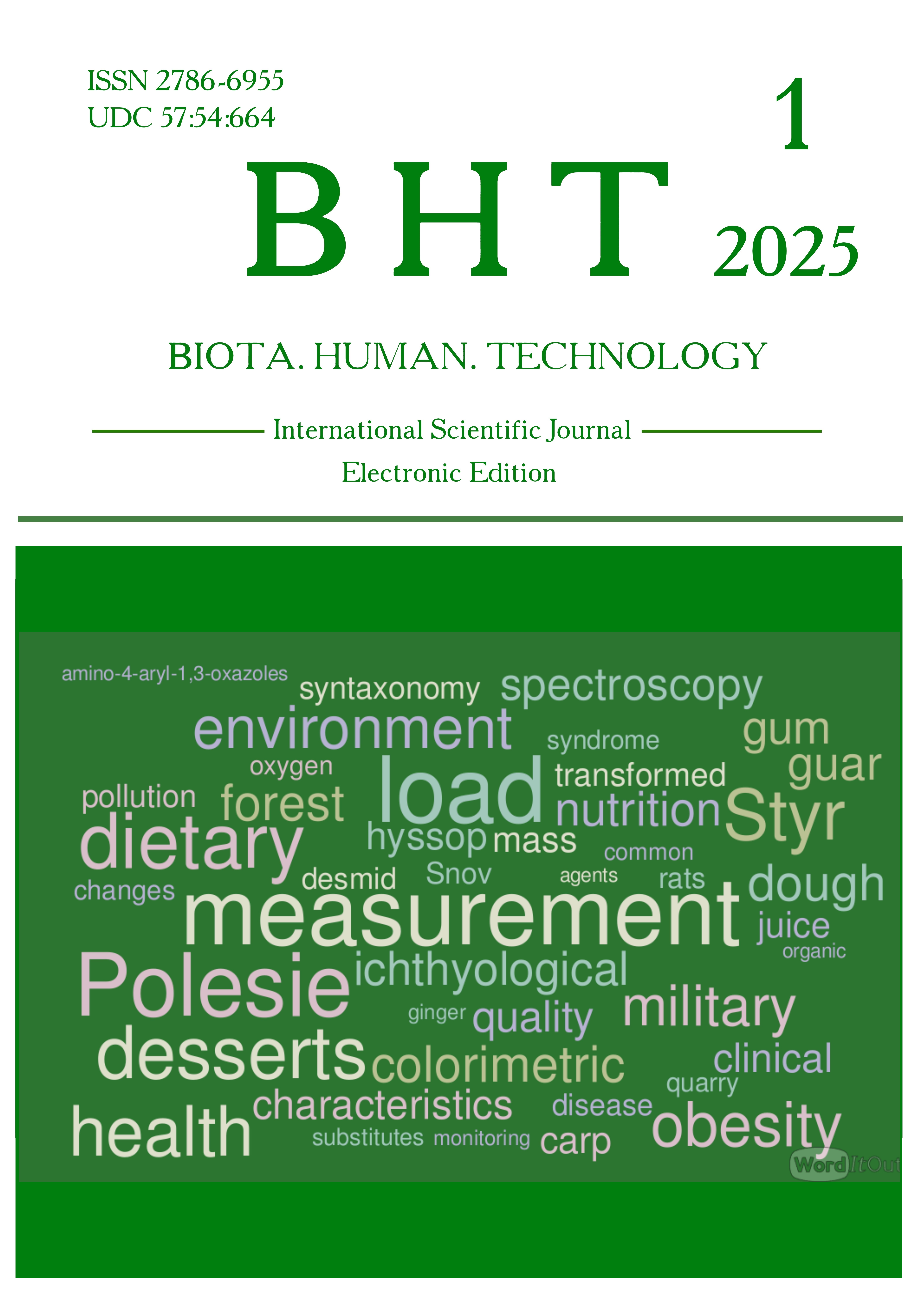QUANTUM CHEMICAL DESCRIPTORS AND BIOLOGICAL ACTIVITY OF 2-AMINO-4-ARYL-1,3-OXAZOLES
DOI:
https://doi.org/10.58407/bht.1.25.11Keywords:
2-amino-4-aryl-1,3-oxazoles, quantum-chemical descriptors, pharmacological activity, correlation dependenceAbstract
Purpose of the work. To calculate quantum chemical descriptors for 2-amino-4-aryl-1,3-oxazole derivatives, prediction of possible protein targets, and establishment of correlational dependencies of the type "biological activity - quantum-chemical descriptor".
Methodology. The study was conducted using ChemOffice software packages (PerkinElmer Informatics Inc, 2018), ACDLabs (Advanced Chemistry Development Inc.), online resources Molinspiration Cheminformatics (Slovensky Grob, Slovakia https://molinspiration.com/cgi/properties), OSIRIS Property Explorer (Idorsia Pharmaceuticals Ltd, Switzerland Molecular Properties Prediction, https://www.organic-chemistry.org/prog/peo/), SwissTargetPrediction (SIB Swiss Institute of Bioinformatics, http://www. swisstargetprediction.ch/), SuperPred (Structural Bioinformatics Group, Institute of Physiology Charité-University Medicine, Berlin, https://prediction.charite.de/subpages/target_prediction.php), ProTox (Structural Bioinformatics Group, Institute of Physiology Charité-University Medicine, Berlin https://tox.charite.de/protox3). Microsoft Excel was used to perform correlation and regression analyses in the coordinates of binding probability - quantum chemical descriptors.
Scientific novelty. Were evaluated the pharmacological activity of new 2-amino-4-aryl-1,3-oxazole derivatives and identified correlations between the probability of their effectiveness and the quantum chemical parameters of the molecules.
Conclusions. Several correlations have been established for the probable ligands, focusing on those with the highest binding probability as well as various quantum chemical descriptors, including the charges on oxygen and nitrogen atoms and the energies of the highest occupied and lowest vacant molecular orbitals. The results obtained are valuable for making more informed predictions about the biological activity of new 2-amino-4-aryl-1,3-oxazole derivatives and for guiding the synthesis of promising dosage forms.
Downloads
References
Aihara, J. (1999). Reduced HOMO-LUMO Gap as an Index of Kinetic Stability for Polycyclic Aromatic Hydrocarbons. The Journal of Physical Chemistry A, 103, 7487-7495. https://doi.org/ 10.1021/jp990092i
Alias, A., Zabidi, Z., Zakaria, N., Mahmud, Z., & Ali, R. (2021). Biological Activity Relationship of Cyclic and Noncyclic Alkanes Using Quantum Molecular Descriptors. Open Journal of Applied Sciences, 11, 966-984. https://doi.org/10.4236/ojapps.2021.118070
Bondar, O., Vasilenko, K., Makei, O., & Kurmakova, I. (2022). Quantum-chemical characterization of the new [1,2,4]triazolo[1,5-a]pyrimidine derivatives with biological activity. BHT: Biota. Human. Technology, 1(1), 98–106. (in Ukrainian)
Бондар О., Василенко К., Макей О., Курмакова І. Квантово-хімічна характеристика нових біологічно активних похідних [1,2,4]триазоло[1,5-а]піримідину. BHT: Biota. Human. Technology. 2022. №1(1). С. 98–106.
Chekman, I. S. (2010). Quantum pharmacology: new direction in materia medica. Science and innovations, 6(2), 29 – 35. https://doi.org/10.15407/scin6.02.029 (in Ukrainian).
Чекман І.С. Квантова фармакологія: новий напрям у лікознавстві. Наука та інновації. 2010. Т. 6. № 2. С. 29 –35. https://doi.org/10.15407/scin6.02.029
Gallo, K., Goede, A., Preissner, R., & Gohlke, B. O. (2022). SuperPred 3.0: drug classification and target prediction-a machine learning approach. Nucleic Acids Research, 50(W1), W726–W731. https://doi.org/10.1093/nar/gkac297
Gulseven Sidir, Y., & Sidir, I. (2023). The study on QSAR and relations between molecular descriptors of 5, 8- quinolinequinone derivatives. Journal of Science. 36(4): 1795-1809. https://doi.org/10.35378/gujs.1051216
Li, N., Xu, Y., Xia, Q., Bai, C., Wang, T., Wang, L., … Chen, Y. (2014). Simplified captopril analogues as NDM-1 inhibitors. Bioorganic & medicinal chemistry letters, 24(1), 386–389. https://doi.org/10.1016/j.bmcl.2013.10.068
Lipinski, C. A., Lombardo, F., Dominy, B. W., & Feeney, P. (2001). Experimental and computational approaches to estimate solubility and permeability in drug discovery and development settings. Advanced Drug Delivery Reviews, 46, 3-26. https://doi.org/10.1016/s0169-409x(00)00129-0
Lukovits, I., Biczó, G., & Pataki, I. (1976). Correlation Between Pharmacological Activity Indices and Quantum Chemical Indices of Some Phenylethylamine Derivatives. In: Tichý, M. (eds) Quantitative Structure-Activity Relationships. Experientia Supplementum, 23. Birkhäuser, Basel. https://doi.org/10.1007/978-3-0348-5795-6_24
Muegge, I. (2003). Selection criteria for drug-like compounds. Medicinal Research Reviews, 23(3), 302-321. https://doi.org/10.1002/med.10041
Pedras, M. S. C., & Abdoli, A. (2013). Metabolism of the phytoalexins camalexins, their bioisosteres and analogues in the plant pathogenic fungus Alternaria brassicicola. Bioorganic & Medicinal Chemistry, 21, 4541–4549. https://doi.org/10.1016/j.bmc.2013.05.026
Pentyuk, O. O., Kachula, S. O., & Gery`ch, X. O. (2004). Polymorphism, physiological functions, regulation, role in pathology. Ukrainian biochemical journal, 46(5), 16-28. (in Ukrainian)
Петнюх О.О., Качула С.О., Герич О.Х. Цитохром Р450Е1. Поліморфізм, фізіологічні функції, регуляція, роль у патології. Український біохімічний журнал. 2004. Т.46, №5. С.16-28.
Politzer, P., Lane, P., &Murray, J. S. (2016). Electrostatic Potentials, Intralattice Attractive Forces and Crystal Densities of Nitrogen-Rich C,H,N,O Salts. Crystals, 6(1), 7, 1-14. https://doi.org/10.3390/cryst6010007
Prasanna, S. & Doerksen, R. J. (2009). Topological polar surface area: a useful descriptor in 2D-QSAR. Current Medicinal Chemistry, 16(1), 21-41. https://doi.org/10.2174/092986709787002817
Raunio, H., Juvonen, R. O., Poso, A., Lahtela-Kakkonen, M., & Rahnasto-Rilla, M. (2016). Common and distinct interactions of chemical inhibitors with cytochrome P450 CYP1A2, CYP2A6 and CYP2B6 enzymes. Drug Metabolism Letters, 10, 56–64. https://doi.org/10.2174/1872312810666151204002456
Sánchez-Martínez, J. D, Valdés, A., Gallego, R., Suárez-Montenegro, Z. J., Alarcón, M., Ibañez, E., Alvarez-Rivera, G., & Cifuentes, A. (2022). Blood–Brain Barrier Permeability Study of Potential Neuroprotective Compounds Recovered From Plants and Agri-Food by-Products. Front. Nutr., 9, 924596. https://doi.org/10.3389/fnut.2022.924596.
Tretiak, I. Yu., & Makey, O. P. Syntheses of 2-amino-4-aryl-1,3-oxazoles. Modern problems of science, education and society: Proceedings of the 3rd International scientific and practical conference. SPC “Sci-conf.com.ua”. Kyiv, Ukraine, 2023. P. 363-365. (in Ukrainian).
Третяк І. Ю., Макей О. П. Синтез 2-аміно-4-арил-1,3-оксазолів. Modern problems of science, education and society. Proceedings of the 3rd International scientific and practical conference. SPC “Sci-conf.com.ua”. Kyiv, Ukraine. 2023. P. 363-365.
Velec, H. F., Gohlke, H., & Klebe, G. (2005). DrugScore(CSD)-knowledge-based scoring function derived from small molecule crystal data with superior recognition rate of near-native ligand poses and better affinity prediction. Journal of Medicinal Chemistry, 48(20), 6296-6303. https://doi.org/10.1021/jm050436v
Downloads
Published
How to Cite
Issue
Section
License
Copyright (c) 2025 Олена Бондар, Інна Тарасенко, Ірина Курмакова, Олександр Макей

This work is licensed under a Creative Commons Attribution 4.0 International License.


